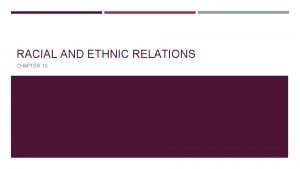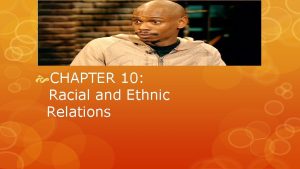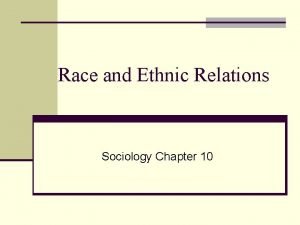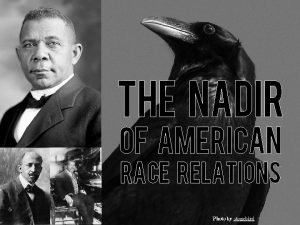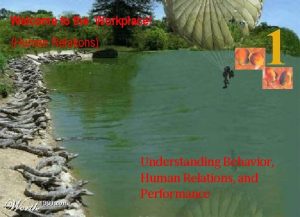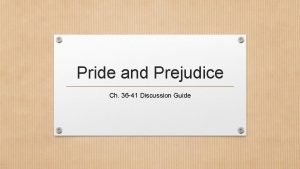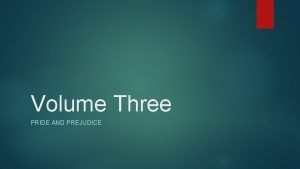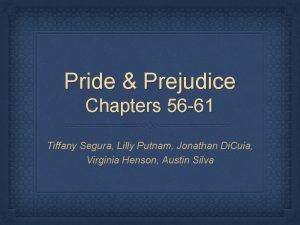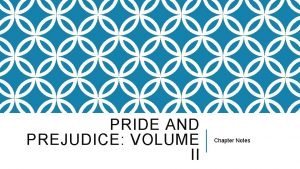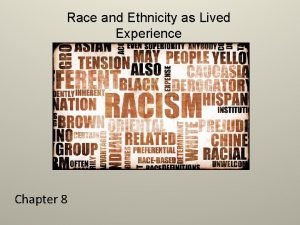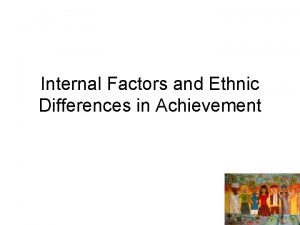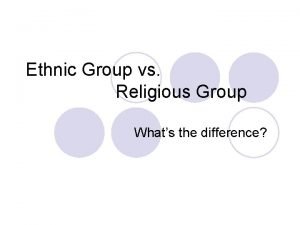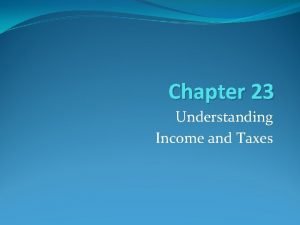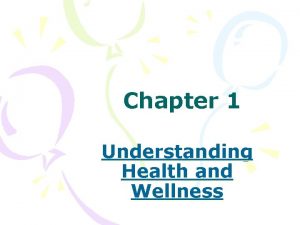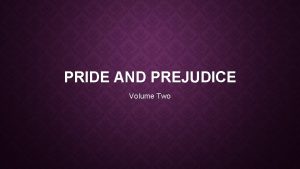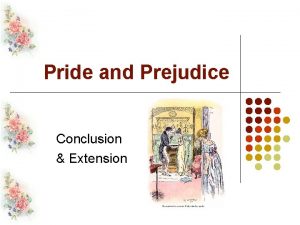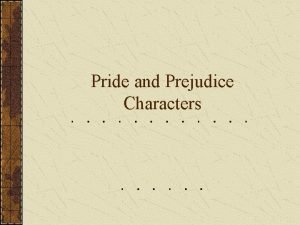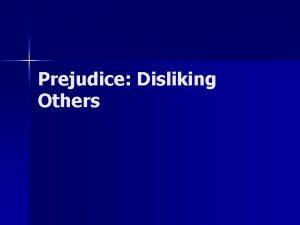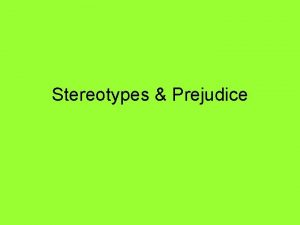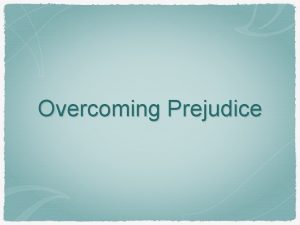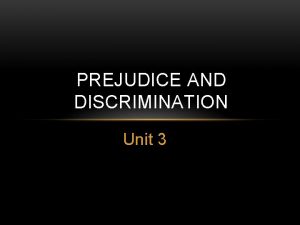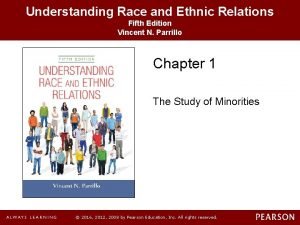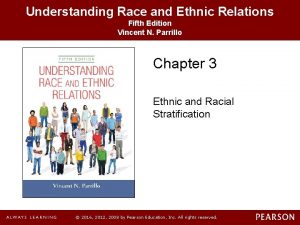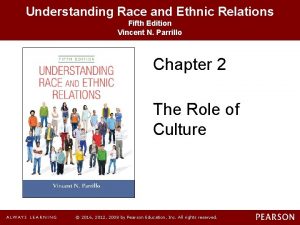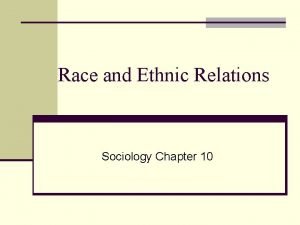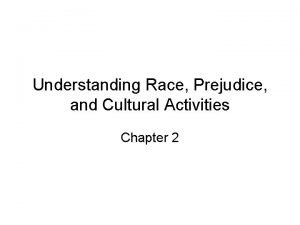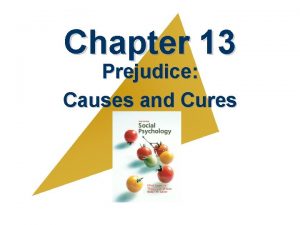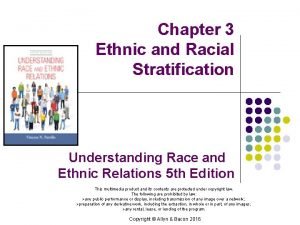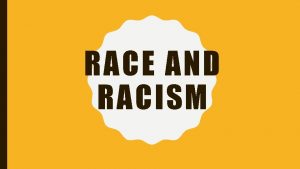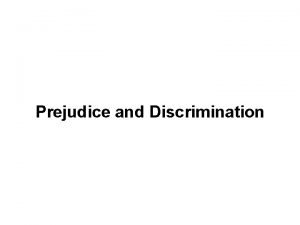Chapter 4 Prejudice Understanding Race and Ethnic Relations






































- Slides: 38

Chapter 4 Prejudice Understanding Race and Ethnic Relations 5 th Edition This multimedia product and its contents are protected under copyright law. The following are prohibited by law: nany public performance or display, including transmission of any image over a network; npreparation of any derivative work, including the extraction, in whole or in part, of any images; nany rental, lease, or lending of the program. Copyright © Allyn & Bacon 2016

Learning Objectives 1. 2. 3. To develop an understanding of prejudice To increase an awareness of the dangers of stereotyping, and its perpetuation through ethnic humor and the mass media To explore the possible causes of prejudice and its elimination

Prejudice From the Latin praejudicim, prejudice originally referred to a prejudgment based on a hasty generalization obtained before an examination of all the facts - Social scientists discovered that individuals oftentimes arose after individuals came into contact with certain groups and had certain knowledge of one another

The Psychology of Prejudice Cognitive level of prejudice encompasses a person’s beliefs and perceptions of a group as threatening or nonthreatening, inferior or equal, seclusive or intrusive, impulse gratifying, acquisitive, or possessing other positive or negative characteristics

The Psychology of Prejudice n Emotional level of prejudice • Encompasses the feelings that a minority group • • • arouses in an individual These feelings may be based on stereotypes from the cognitive level but they represent a more intense stage of personal involvement Emotional attitudes may be negative or positive These feelings, based on beliefs about the group, may be triggered by social interaction or by the possibility of interaction

The Psychology of Prejudice Action-orientation level of prejudice • Is the positive or negative predisposition to engage in discriminatory behavior • A person harboring strong feelings about a certain racial or ethnic group may have a tendency to act for or against them

The Psychology of Prejudice Self-justification • Involves denigrating a person or group to justify maltreatment of them • Leads to prejudice and discrimination against members of another group

Prejudiced personality (Dispositional prejudice) “Authoritarian personality” • Rigid in beliefs • Possess conventional values • Intolerant of weakness in self or others • Highly punitive • Suspicious • Highly respectful of authority

Authoritarian personality • Developed by Adorno and colleagues • Measured by questionnaire called the “F • scale” (online version available at http: //www. anesi. com/fscale. htm) Data are correlational; these people’s parents also tend to be highly prejudiced

The Psychology of Prejudice Frustration • Result of relative deprivation in which expectations remain unsatisfied and frustrated people may easily strike out against the perceived cause of their frustration. The result may be displaced aggression where the frustrated individual or group redirects anger against a more visible, vulnerable, and socially sanctioned target, one unable to strike back Scapegoating • Involves placing blame on others for something that is not their fault

Scapegoating targets • Groups that are disliked • Groups that are visible • Groups that are relatively powerless • Aggression generally escalates as far as societal norms allow (e. g. , individual attacks, lynching, ethnic cleansing, genocide)

Table 4. 1 Approaches to the Study of Prejudice Approach Concept Example Psychological Self-justification We blame others to justify our mistreatment of them. “They asked for it!” Personality Strict child rearing results in an intolerant adult. “I can’t stand people who aren’t neat!” Frustration Unmet expectations lead to finding a scapegoat. “She didn’t deserve that promotion. I did!” Sociological Socialization We learn tolerance or intolerance from others. “They just not l like us. They’re lazy!” Economic Competiton We become hostile when we think others are a threat. “Immigrants take jobs away from Americans!” Social Norms We learn to conform to prevailing attitudes. “Don’t be seen talking to those people!” Source: Page 91, Parillo, Understanding Race and Ethnic Relations (Fourth Edition)

The Sociology of Prejudice • No single factor explains prejudice • Prejudice is a complex phenomenon and is • most likely the product of more than one causal agent Sociologists tend to stress social forces and processes such as Socialization § Economic Competition § Social Norms §

Socialization Process: Process whereby individuals acquire the values, statuses, attitudes, beliefs, and perceptions of the wider culture - Example: Jim Crow laws of the 1890’s and early 20 th century, which established segregated public facilities throughout the South. Subsequent generations of Southerners accepted as proper.

Economic Competition People tend to be more hostile towards others when they feel their security is threatened. Negative stereotyping, prejudice, and discrimination increase markedly whenever competition for jobs increases. - Example: Chinese immigrant laborers working on the transcontinental railroad during the 1870’s. Hostility towards Chinese increased when economy worsened in 1873 (i. e. labeled the “Yellow menace”).

Social Norms: The socially shared rules defining what is proper and improper. A direct relationship exists between degree of conformity and degree of prejudice. - Example: Pettigrew study (1950) discovered that Southerners in 1950’s who served in military with Blacks generally had less prejudiced attitudes then those Southern Whites who didn’t in large part because military had less prejudiced social norms.

Stereotyping Stereotype • An oversimplified generalization by which we attribute certain traits or characteristics to a group without regard to individual differences Ethnophaulism • A derogatory word or expression used to describe a racial or ethnic group Ethnic humor • Likely to be favorably or unfavorably received depending on listener’s attitude toward group being ridiculed

INFLUENCE OF TELEVISION Prejudice and the media • George Gerbner’s exhaustive surveys of • • media representations routinely show that women and minorities appear in television far less often than in reality Similar examinations of magazine and newspaper comics show women and minorities significantly under- or misrepresented 1970’S U. S. Commission on Civil Rights: Charged television industry with perpetuating racial and gender stereotypes

Consequences of prejudiced portrayals in the media • We tend to accept or believe things we • • see with great frequency We cannot account for what we never see represented (e. g. women aren’t or can’t be leaders since we never see them portrayed as leaders) Debilitating impact on the self-concept of those who are not represented

Selective Perception • tendency of individuals to absorb information that accords with their own beliefs and rationalize information that doesn’t.

Can Prejudice Be Reduced? Two basic approaches to reducing prejudice • Promoting interaction between dominant and minority groups in all aspects of living, by either voluntary or compulsory means • Dispensing information that destroys stereotypes and exposes rationalizations (selfjustifications) Neither approach has been successful in all instances

Diversity Training • creation of workplace environment that promotes positive intergroup interaction. Studies find latter to be more efficient, have higher morale, and retain experienced personnel.

Chapter 4 Supplement: Racism, Sexism, and Homophobia Society: The Essentials, ch. 8 “Racial and Ethnic Inequality, ” ch. 9 “Sex, Gender, Sexuality”, 7 th Edition by Brinkerhoff, White, Ortega, and Weitz. Copyright 2008 by Thomson Wadsworth. All rights reserved. Strangers To These Shores, ch. 14 “Sexual Orientation, Handicaps, 10 th Edition by Vincent Parillo. Copyright 2011 by Pearson Education. All rights reserved. Society: The Basics , ch. 6 “Sexuality”, 10 th Edition by John Macionis. Copyright 2009 by Pearson Education, Upper Saddle River, NJ 07458. All rights reserved.

Prejudice • Prejudice is an irrational, negative attitude toward a category of people. • Racism is the belief that inherited physical characteristics associated with racial groups determine individuals’ abilities and characteristics and provide a legitimate basis for unequal treatment. Society: The Essentials, ch. 8 “Racial and Ethnic Inequality”

Prejudice and stereotypes are not limited to ethnic group relationships. • Many younger Americans stereotype older people as hags, crones, dirty old men, and the like. • Even when we admire elderly persons, we tend not to see them as whole and unique individuals. • When these stereotypes coalesce into prejudice, we refer to it as ageism: the belief that older persons are less capable and worthy than younger people. Society: The Essentials, ch. 8 “Racial and Ethnic Inequality”

Conflict Theory: Sexism and Discrimination • According to conflict theorists, women’s disadvantage benefit men and the capitalist class. • Sexism is the belief that women and men have biologically different capacities that form a legitimate basis for unequal treatment. • Discrimination is the natural result of sexism. Society: The Essentials, ch. 9 “Sex, Gender, Sexuality”

Why Women and Men Have Different Jobs • Gendered Occupations - Lower paying jobs tend to be “women’s work”. • Different qualifications - Women are less likely to have as much experience or education as men. • Discrimination works against women’s options in the world of work. Society: The Essentials, ch. 9 “Sex, Gender, Sexuality”

Unequal Power in Social Institutions • Women’s subordinate position is built into most social institutions. • In colleges, women’s basketball coaches are paid less than men’s basketball coaches. • In politics, prejudice against women leaders remains strong, and women still comprise only a minority of major elected officials in the United States and around the world. Society: The Essentials, ch. 9 “Sex, Gender, Sexuality”

Unequal Power in Interaction • Studies of informal conversations show that men regularly dominate women in verbal interaction. • Men take up more of the speaking time, they interrupt women more often, and most important, they interrupt more successfully. • Women are more placating and less assertive in conversation than men, and women are more likely to state their opinions as questions. Society: The Essentials, ch. 9 “Sex, Gender, Sexuality”

Sexual Harassment • Sexual harassment includes unwelcome sexual advances, requests for sexual favors, and other unwanted verbal or physical conduct of a sexual nature. • Although estimates vary depending on the definition and sample used, as many as half of all working women probably experience sexual harassment during their lifetime. Society: The Essentials, ch. 9 “Sex, Gender, Sexuality”

The Feminist Movement • Women and men have taken to the streets—as well as to the courts—to fight to improve women’s lives. Society: The Essentials, ch. 9 “Sex, Gender, Sexuality”

§ Homophobia § Discomfort over close personal interaction with people thought to be gay, lesbian, or bisexual Society: The Basics, 10 th Edition by John Macionis Copyright 2009 by Pearson Education, Upper Saddle River, NJ 07458. All rights reserved.

HOMOSEXUALITY IN THE UNITED STATES Openness about being homosexual was uncommon in the United States prior to the 1960 s, except in major cities, where strong subcultures thrived. Strangers to These Shores, Tenth Edition by Vincent N. Parrillo © 2011 Pearson Education, Inc. All rights reserved

HOMOSEXUALITY IN THE UNITED STATES The homophobia of the 1950 s and the resulting stigma and harm that could result from openness about their sexual preference led many homosexuals to adopt a low profile despite the efforts of activist organizers in several cities.

CURRENT ISSUES As of 2010, same-sex marriages were legally permissible in 21 countries, including all 50 states in the US; eight European countries allow civil unions or domestic partnerships.

How Many Gay People Are There? § Hard question to answer § People are not always willing to discuss their sexuality with strangers or even family members § Some social scientists estimate 10% § How homosexuality is defined makes a big difference § Less than 1% describe themselves as bisexual § Many do not think of themselves as gay or straight § Behavior reflects elements of gay and straight living Society: The Basics, 10 th Edition by John Macionis Copyright 2009 by Pearson Education, Upper Saddle River, NJ 07458. All rights reserved.

Figure 6. 3 (p. 159) Share of the U. S. Population that is Homosexual The percentage of people who are classified as having a homosexual orientation depends on how this concept is operationalized. Research suggests that 2. 8 percent of adult men and 1. 4 percent of adult women claim a homosexual identity. Source: Adapted from Laumann et al. (1994). Society: The Basics, 10 th Edition by John Macionis Copyright 2009 by Pearson Education, Upper Saddle River, NJ 07458. All rights reserved.

The Gay Rights Movement § Change in public attitudes toward homosexuality is a result of the Gay Rights Movement § 1973 – American Psychiatric Association § Homosexuality is not an illness but “a form of sexual behavior” Society: The Basics, 10 th Edition by John Macionis Copyright 2009 by Pearson Education, Upper Saddle River, NJ 07458. All rights reserved.
 Chapter 10 racial and ethnic relations
Chapter 10 racial and ethnic relations Chapter 10 racial and ethnic relations
Chapter 10 racial and ethnic relations Chapter 10 racial and ethnic relations review worksheet
Chapter 10 racial and ethnic relations review worksheet Pelton turbine efficiency
Pelton turbine efficiency Function of spillway
Function of spillway Data race vs race condition
Data race vs race condition Nadir of race relations
Nadir of race relations Employee relations in public relations
Employee relations in public relations Understanding human relations
Understanding human relations Pride and prejudice volume 3 summary
Pride and prejudice volume 3 summary Pride and prejudice chapter 16 summary
Pride and prejudice chapter 16 summary Pride and prejudice chapter 43
Pride and prejudice chapter 43 Being mr wickham
Being mr wickham Pride and prejudice chapter 56
Pride and prejudice chapter 56 Pride and prejudice chapter 30 summary
Pride and prejudice chapter 30 summary Chapter 8: race and ethnicity as lived experience
Chapter 8: race and ethnicity as lived experience To kill a mockingbird discussion questions chapters 1-5
To kill a mockingbird discussion questions chapters 1-5 Pride and prejudice irony
Pride and prejudice irony Ethnicity in postcolonialism
Ethnicity in postcolonialism Internal factors and ethnic differences in achievement
Internal factors and ethnic differences in achievement What's the difference between ethnic and religious group
What's the difference between ethnic and religious group How are ethnic groups and religious groups related
How are ethnic groups and religious groups related Chapter 23 understanding income and taxes
Chapter 23 understanding income and taxes The ability to locate interpret and apply information
The ability to locate interpret and apply information Understanding your health and wellness chapter 1
Understanding your health and wellness chapter 1 Chapter 1 understanding your health and wellness
Chapter 1 understanding your health and wellness Lesson 4 promoting health and wellness
Lesson 4 promoting health and wellness Chapter 1 understanding health and wellness lesson 2
Chapter 1 understanding health and wellness lesson 2 Chapter 1 lesson 2 what affects your health
Chapter 1 lesson 2 what affects your health Chapter 1 health and wellness fundamentals
Chapter 1 health and wellness fundamentals Chapter 1 understanding your health and wellness
Chapter 1 understanding your health and wellness Chapter 5 understanding and comparing distributions answers
Chapter 5 understanding and comparing distributions answers Chapter 1 understanding health and wellness lesson 3
Chapter 1 understanding health and wellness lesson 3 Location of pride and prejudice
Location of pride and prejudice Pride and prejudice volume 2
Pride and prejudice volume 2 Pride and prejudice conclusion
Pride and prejudice conclusion Pride and prejudice characters
Pride and prejudice characters Jane austen historical context
Jane austen historical context Nature and power of prejudice in social psychology
Nature and power of prejudice in social psychology
